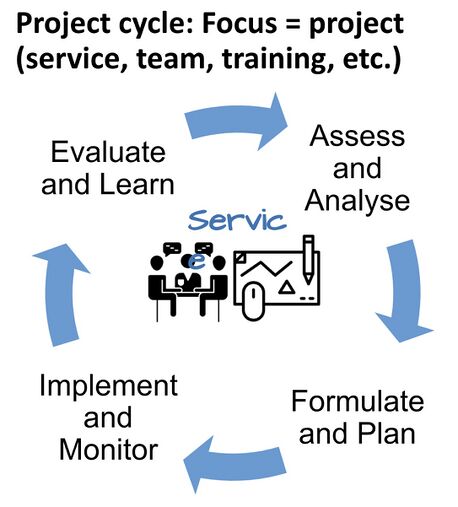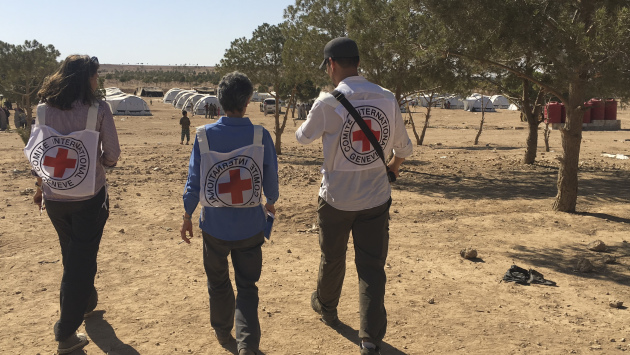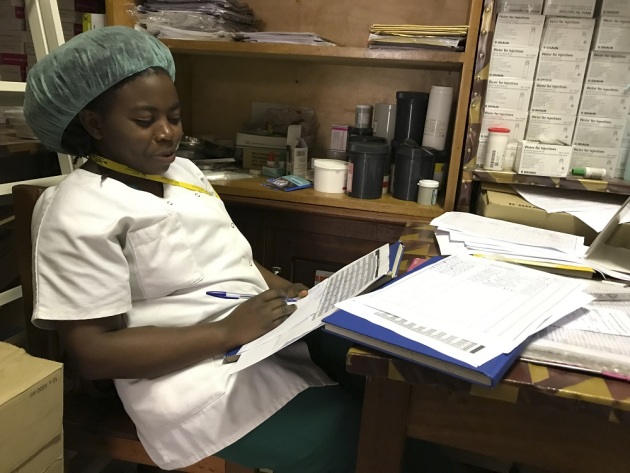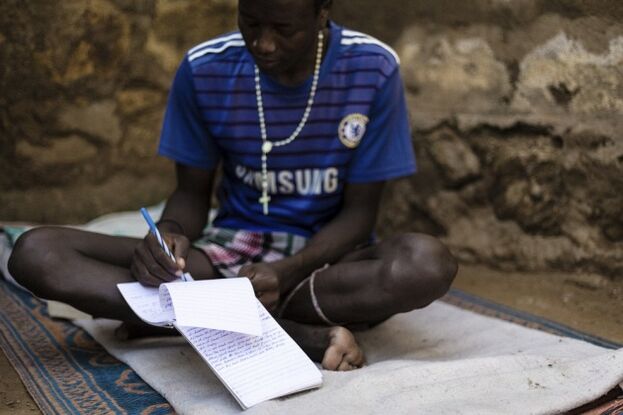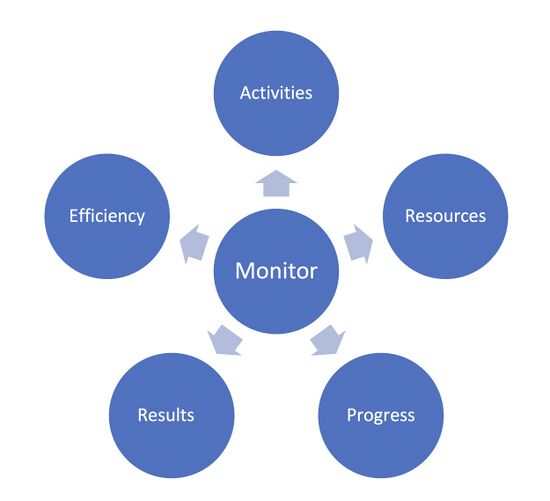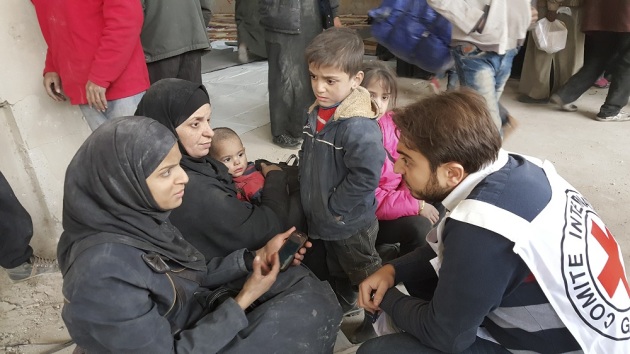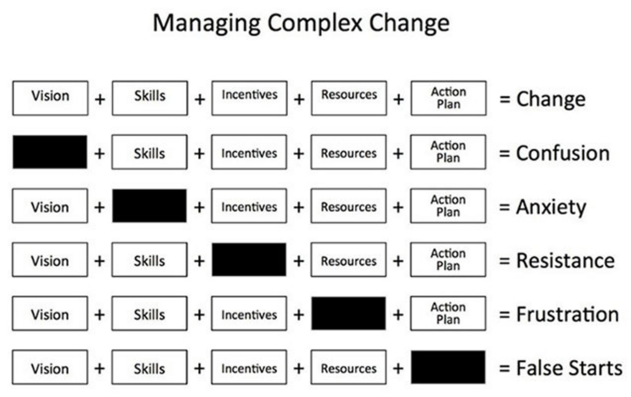ICRC Physiotherapy Standards Project Cycle: Difference between revisions
Kim Jackson (talk | contribs) No edit summary |
Kim Jackson (talk | contribs) No edit summary |
||
| (11 intermediate revisions by the same user not shown) | |||
| Line 1: | Line 1: | ||
<div class="noeditbox">Welcome to [[ICRC Physiotherapy Standards Content Development Project|The ICRC Physiotherapy Standards Content Development Project]]. This space was created by Physiopedia for the creation of content relating to the ICRC Physiotherapy Standards Workshop. Please do not edit unless you are involved in this project, but please come back in the near future to check out new information!!</div> <div class="editorbox"> | <div class="noeditbox">Welcome to [[ICRC Physiotherapy Standards Content Development Project|The ICRC Physiotherapy Standards Content Development Project]]. This space was created by Physiopedia for the creation of content relating to the ICRC Physiotherapy Standards Workshop. Please do not edit unless you are involved in this project, but please come back in the near future to check out new information!!</div> <div class="editorbox"> | ||
| Line 13: | Line 12: | ||
== Introduction == | == Introduction == | ||
Project Cycle Management (PCM) describes the process of planning and managing projects. Setting clear goals and objectives will help to plan for better results. The [[ICRC Physiotherapy Standards Project Cycle|project cycle]] helps to guide the RBM by outlining the steps that lead to successful outcomes. | Project Cycle Management (PCM) describes the process of planning and managing projects. Setting clear goals and objectives will help to plan for better results. The [[ICRC Physiotherapy Standards Project Cycle|project cycle]] helps to guide the [[Results Based Management|Results Based Management (RBM)]] by outlining the steps that lead to successful outcomes. | ||
The ICRC describes planning for results as "A corporate function that assesses context, target groups, problems/needs, risks, constraints and opportunities and sets priorities to ensure an appropriate level of coordination and alignment of actions and resources towards the achievement of expected results"[] | |||
The ICRC describes planning for results as "A corporate function that assesses context, target groups, problems/needs, risks, constraints and opportunities and sets priorities to ensure an appropriate level of coordination and alignment of actions and resources towards the achievement of expected results"<ref name=":0">ICRC. [https://www.icrc.org/en/doc/assets/files/publications/icrc-001-0951.pdf Programme/project management: The results-based approach]. ICRC. 2008</ref> | |||
The aim of PCM is to maximise the benefits of projects for the intended population and ensure that projects: | The aim of PCM is to maximise the benefits of projects for the intended population and ensure that projects: | ||
| Line 30: | Line 24: | ||
*are sustainable | *are sustainable | ||
== Types of Projects in Rehabilitation == | == Types of Projects in Rehabilitation == | ||
Project in this case can refer to a Physical Therapy (PT) department, a PT team, a [ | Project in this case can refer to a Physical Therapy (PT) department, a PT team, a [[Continuing Professional Development / Continuing Education (CPD/CE)|Continuing Professional Development]] cycle. Regardless of the type of project, any intervention that is identified will have similar characteristics<ref name=":0" />: | ||
* Their purpose is to solve “a problem” | |||
* A deadline will be set and agreed upon, i.e. a timeframe and a completion date. | |||
* It will take into account current services and opportunities based on available resources and local capacity | |||
* It benefits a specific, identified group | |||
* It is implemented by a team and has a team leader | |||
The ICRC adopted the [[Results Based Management|Results-Based Management]] (RBM) approach, in the mid 1990s, with a aim of strengthening performance and to justify and demonstrate the effect of its policies and interventions when working with people affected by armed conflict and other situations of violence. | |||
==Project Cycle Management Planning for ResultsThe Process== | ==Project Cycle Management Planning for ResultsThe Process== | ||
In order for any project to be successful it is important to set objectives that focus on the population and their current situation and the intended outcome of any intervention.[] The objectives need to be written with the desired outcome in mind so that that the results can be measured and assessed to ensure that there has been a positive impact on the targeted population []. Once the objectives have been set and been agreed the following phases are necessary to ensure that the project is successful and meets the identified goals and desired outcome: | In order for any project to be successful it is important to set objectives that focus on the population and their current situation and the intended outcome of any intervention<ref>World Health Organization. [https://apps.who.int/iris/bitstream/handle/10665/43470/?sequence=1 Quality of care: a process for making strategic choices in health systems]. World Health Organization; 2006.</ref>. The objectives need to be written with the desired outcome in mind so that that the results can be measured and assessed to ensure that there has been a positive impact on the targeted population<ref>Fund, Better Care. [https://www.england.nhs.uk/wp-content/uploads/2015/06/bcf-user-guide-04.pdf.pdf How to understand and measure impact]. 2015.</ref>. Once the objectives have been set and been agreed the following phases are necessary to ensure that the project is successful and meets the identified goals and desired outcome: | ||
*Assess and Analyse -What is the current situation? Identify problems! What caused it? Who is involved? What are we going to achieve? | *Assess and Analyse -What is the current situation? Identify problems! What caused it? Who is involved? What are we going to achieve? | ||
| Line 44: | Line 40: | ||
*Implement and Monitor - This is the stage where activities are undertaken. It is important to monitor throughout the whole project so that any successes and/or changes are identified to meet the set goals | *Implement and Monitor - This is the stage where activities are undertaken. It is important to monitor throughout the whole project so that any successes and/or changes are identified to meet the set goals | ||
*Evaluate and Learn - This can be carried out at any stage highlighting any recommendations and adaptations. | *Evaluate and Learn - This can be carried out at any stage highlighting any recommendations and adaptations. | ||
[[File:ICRC Project Cycle.jpg|center|frameless|507x507px]] | |||
==Assess and Analyse== | ==Assess and Analyse== | ||
[https://docs.google.com/document/d/1e7mm3hKsjuU1tZvYwtTld8qtXesNVXy5/edit Situation Analysis] Word document | The aim of an assessment is to understand a situation in order to identify the problem(s), the source of the problem(s) and the consequences of the problem(s). The purpose of an assessment is not to identify an intervention but to find out whether or not an intervention is required, based on identified needs. The following tools can assist with this stage: | ||
* [https://docs.google.com/document/d/1e7mm3hKsjuU1tZvYwtTld8qtXesNVXy5/edit Situation Analysis] Word document | |||
* [https://docs.google.com/spreadsheets/d/11lBTrelYmbshm3xBgX-0HMua3mzvAlZ6/edit#gid=1473697729 <nowiki>Gap analysis. [Excel document]</nowiki>] | |||
* [https://docs.google.com/spreadsheets/d/1oA1_if6eZHEFrWziTnvmpT-UL2ZWwqpL/edit?usp=drive_web&ouid=115551139920996932020&rtpof=true <nowiki>Physiotherapy competency checklist [Excel document]</nowiki>] | |||
[[File:ICRC PTS PIC1AssessandAnalyse.jpg|center|frameless|630x630px]] | |||
[https://docs.google.com/ | === Situation Analysis === | ||
A situation analysis gives insight into the environment, the needs of the population and current available resources. Once there is an understanding of what is needed it is easier to develop a plan that is realistic and prioritises actions. Here is and example example of a [https://docs.google.com/document/d/1e7mm3hKsjuU1tZvYwtTld8qtXesNVXy5/edit Situation Analysis Tool]. The steps involved in at situation analysis will depend on the stage of the project, but could include Analysis of: | |||
[https://docs.google.com/ | * Current situation, available services and resources, Service needs | ||
* Workforce and multi-disciplinary team - [https://docs.google.com/document/d/11jaIen__VGpTwX6DonfgClTFwIQkfGiVq4nOSPz1Yn0/edit?usp=sharing <nowiki>Examples of key perfomance indicators for physiotherapists [PDF document]</nowiki>] | |||
* Service Users and their needs | |||
* Health, Safety & Service Security | |||
* Physiotherapy Department - [https://drive.google.com/file/d/1rPkHx52FdP1WV1-cBs1cn-YMOKdl38Qp/view?usp=sharing <nowiki>ICRC PT Competency Table [PDF document]</nowiki>] | |||
* Stakeholders | |||
=== | === Gap Analysis === | ||
[https:// | A [https://docs.google.com/spreadsheets/d/11lBTrelYmbshm3xBgX-0HMua3mzvAlZ6/edit#gid=1473697729 gap analysis] is a useful tool that can assist in prioritising service and rehabilitation needs by determining the current performance of your project - against desired goals, as well as identifying any components that are missing from the project. Once a gap has been identified an action plan needs to be developed and incorporated into the the project, including the resources needed, who is responsible for addressing the gap, who will benefit and of course a timeline for implementation. | ||
A gap analysis provides an overview on the current situation and what is needed to reach goals and best service delivery addressing the needs of the population and adding to workforce satisfaction. An example of the steps involved in a gap analysis of a rehabilitation service could include: | |||
[https:// | * The needs of the service user, taking into account - respect, confidentiality, individuality, race, gender, culture and emotional state | ||
* Assessment process | |||
* Analysis of assessment and treatment planning | |||
* Implementing and monitoring treatment plan | |||
* Discharge/transfer process | |||
* Communication with Multidisciplinary team | |||
* Data management | |||
* Physical environment and health and safety of service user and staff | |||
* Human resources | |||
* Continuing education | |||
* Professional conduct | |||
* Quality improvement | |||
== Formulate and Plan == | |||
Setting goals and creating a plan are an important step in the project cycle and will help to prioritise tasks to achieve the end goal. | |||
[[File:ICRC PTS PIC2FormulatandPlan.jpg|center|frameless|630x630px]] | |||
The best way to ensure success is to make sure your goals are [[Sustainable Development Goals|sustainable]] and [[Goal Setting in Rehabilitation#Goal Setting Methods|SMART]] | |||
'''S''' Specific | |||
'''M''' Measurable | |||
'''A''' Attainable or Assignable | |||
'''R''' Realistic | |||
'''T''' Time-related | |||
Once the goals have been set and agreed it is time to develop an [https://docs.google.com/spreadsheets/d/1NO6Nztp2PclAtOh6pwpmyG24R3SFgmrK/edit?usp=sharing&ouid=115551139920996932020&rtpof=true&sd=true action plan].This plan will include: | |||
* SMART goals/objectives identified | |||
* Actions required | |||
* Resources that are needed | |||
* Indicators | |||
* Who is responsible | |||
'''Here are some examples of project action plans:''' | '''Here are some examples of project action plans:''' | ||
| Line 66: | Line 110: | ||
[https://drive.google.com/file/d/13d0POLIiv9dOK-BxFrVyiTtwmhcLtn7V/view?usp=sharing <nowiki>Action plan example PT equipment [Excel document]</nowiki>] | [https://drive.google.com/file/d/13d0POLIiv9dOK-BxFrVyiTtwmhcLtn7V/view?usp=sharing <nowiki>Action plan example PT equipment [Excel document]</nowiki>] | ||
==Implement and Monitor== | ==Implement and Monitor== | ||
Once you have assessed the situation, identified gaps in the service using the situation analysis and gap analysis tools, set objectives and created a timeline to achieve the goals set it is time to put your plan to action. An important part of the implementation stage of project is monitoring. | |||
[[File:ICRC PTS PIC3ImplementandMonitor.jpg|center|frameless|623x623px]] | |||
Monitoring your project is an integral step in the process as it enables you and your team to check on the progress and identify and deviations or obstacles in your plan and take action to put things back on track. This may be by adjusting timelines or setting new steps in the project plan. Regularly collecting and analysing information, that tracks the progress of the project, provides feedback, ensures accountability and also assists in making informed and timely decisions to reach the desired goals and outcome<ref>Crawford P, Bryce P. Project monitoring and evaluation: a method for enhancing the efficiency and effectiveness of aid project implementation. International journal of project management. 2003 Jul 1;21(5):363-73.</ref>. | |||
[[File:ICRC Monitoring Flowchart.jpg|center|frameless|550x550px]] | |||
A useful tool to direct project progress monitoring is the [https://docs.google.com/spreadsheets/d/1NO6Nztp2PclAtOh6pwpmyG24R3SFgmrK/edit?usp=sharing&ouid=115551139920996932020&rtpof=true&sd=true Action plan]. The same tool serves the steps "Formulate and Plan" and "Implement and Monitor". In summary the purpose of monitoring is to: | |||
* Keep track of project/ patient progress | |||
* Keep project staff/ patients motivated | |||
* Empower patients: self-monitoring ‘manage your progress’ | |||
* Correct action/treatment plan if necessary | |||
[ | ==Evaluate and Learn== | ||
The steps in this stages can use the same tools that are used in the Assess and Analyse step, but what we do with this information may be a little different. This is because at this stage we are looking at the success of the project and the focus will be on what went well and does anything need to change and why! | |||
[[File:ICRC PTS PIC4EvaluateandLearn.jpg|center|frameless|630x630px]] | |||
A good model for managing complex change described by Knoster T, Villa R, Thousand J (2000) shows us the steps needed to promote change and how any missing components can lead to confusion, anxiety, resistance, frustration and false starts.<ref>Knoster T, Villa R, Thousand J. A framework for thinking about systems change. Restructuring for caring and effective education: Piecing the puzzle together. 2000:93-128.</ref> | |||
[ | [[File:Complex-Change.png|center|frameless|631x631px]]These changes require considerable effort, negotiations, convincing and resources such as money, time, skills, human resources. The key to this is called change management. The principles of change management must take into account: | ||
* Human side – confront reality and respect culture | |||
* Leaders must start the change and be role models | |||
* Break barriers | |||
* Mobilise people and stimulate ownership | |||
==== How to do it ==== | |||
* Communicate the vision/opportunity | |||
* Design and plan | |||
* Implement: prepare for the unexpected! | |||
* Empower action | |||
* Expect to encounter resistance and see why | |||
* Support, reward, training, TOOLS | |||
== The Continual Cycle == | |||
Once all gaps have been addressed it is important to re-assess, which may identify a new objectives or problems and the beginning of new cycle. So although the project may be time-limited, it is important to ensure quality through re-assessment, therefore the cycle is continual and never ending. | |||
== Resources == | == Resources == | ||
* [https://icrc.scenari.eu/public/Health/Health_Wiki/PTS/ICRC_PhysiotherapyStandards.zip/co/PC_1.html Video - RBM in a nutshell] | * [https://icrc.scenari.eu/public/Health/Health_Wiki/PTS/ICRC_PhysiotherapyStandards.zip/co/PC_1.html Video - RBM in a nutshell] | ||
'''For further reading''' | |||
* [https://drive.google.com/file/d/1rSwoTdoMKFFHYNXxmi7YwdkPS6BkumX9/view?usp=sharing <nowiki>Format for Journal Club [PowerPoint Presentation]</nowiki>] | |||
* [https://drive.google.com/file/d/1r4X-fVBqBC4FVxmczzx9C772LbPNsiMe/view?usp=sharing <nowiki>Journal Club summary template [Word Document]</nowiki>] | |||
* [https://drive.google.com/file/d/1h2KuD5-DmBMolZbLMjQ5HeYjEnHBtWad/view?usp=sharing <nowiki>PEDro scale [Word Document]</nowiki>] | |||
* [https://drive.google.com/file/d/1jIDeIMrbqVPhOqPpb_Z_a8hKsevmDMkX/view?usp=sharing <nowiki>Physiotherapy outcomes meetings info [Word document]</nowiki>] | |||
* [https://drive.google.com/file/d/1GJSfwabU7jh_gGSJJyA5s8PAXyZX_SDk/view?usp=sharing <nowiki>PRISMA checklist [PDF doc]</nowiki>] | |||
* [https://drive.google.com/file/d/1RzwU8ZxzxvNRGJOp7G5Q-Kix1HfKDRqs/view?usp=sharing <nowiki>A Simple Guide to Change Management [PDF doc]</nowiki>] | |||
* [https://drive.google.com/file/d/18-a7JbbAjp3Vx606_u0rA00unNig_-EF/view?usp=sharing <nowiki>Reflective Meeting Info Sheet Sample [Word Doc]</nowiki>] | |||
== References == | == References == | ||
<references /> | <references /> | ||
[[Category:ICRC Physiotherapy Standards Content Development Project]] | |||
[[Category:ICRC Physiotherapy Standards Content Development Project]] | [[Category:ICRC Physiotherapy Standards Content Development Project]] | ||
Latest revision as of 14:18, 6 October 2021
Original Editors - ICRC uploaded by Kim Jackson
Top Contributors - Kim Jackson and Admin
Related Pages[edit | edit source]
- Professional Standards in (ICRC) Physiotherapy
- ICRC Physiotherapy Standards Project Cycle
- ICRC Physiotherapy Standards Rehab Cycle
Introduction[edit | edit source]
Project Cycle Management (PCM) describes the process of planning and managing projects. Setting clear goals and objectives will help to plan for better results. The project cycle helps to guide the Results Based Management (RBM) by outlining the steps that lead to successful outcomes.
The ICRC describes planning for results as "A corporate function that assesses context, target groups, problems/needs, risks, constraints and opportunities and sets priorities to ensure an appropriate level of coordination and alignment of actions and resources towards the achievement of expected results"[1]
The aim of PCM is to maximise the benefits of projects for the intended population and ensure that projects:
- are relevant and will meet the needs of the intended population
- that objectives can be realistically achieved and take into account the environment and available personnel and resources
- are sustainable
Types of Projects in Rehabilitation[edit | edit source]
Project in this case can refer to a Physical Therapy (PT) department, a PT team, a Continuing Professional Development cycle. Regardless of the type of project, any intervention that is identified will have similar characteristics[1]:
- Their purpose is to solve “a problem”
- A deadline will be set and agreed upon, i.e. a timeframe and a completion date.
- It will take into account current services and opportunities based on available resources and local capacity
- It benefits a specific, identified group
- It is implemented by a team and has a team leader
The ICRC adopted the Results-Based Management (RBM) approach, in the mid 1990s, with a aim of strengthening performance and to justify and demonstrate the effect of its policies and interventions when working with people affected by armed conflict and other situations of violence.
Project Cycle Management Planning for ResultsThe Process[edit | edit source]
In order for any project to be successful it is important to set objectives that focus on the population and their current situation and the intended outcome of any intervention[2]. The objectives need to be written with the desired outcome in mind so that that the results can be measured and assessed to ensure that there has been a positive impact on the targeted population[3]. Once the objectives have been set and been agreed the following phases are necessary to ensure that the project is successful and meets the identified goals and desired outcome:
- Assess and Analyse -What is the current situation? Identify problems! What caused it? Who is involved? What are we going to achieve?
- Formulate and Plan - What is the desired outcome? Set objectives, strategies and activities that are needed!
- Implement and Monitor - This is the stage where activities are undertaken. It is important to monitor throughout the whole project so that any successes and/or changes are identified to meet the set goals
- Evaluate and Learn - This can be carried out at any stage highlighting any recommendations and adaptations.
Assess and Analyse[edit | edit source]
The aim of an assessment is to understand a situation in order to identify the problem(s), the source of the problem(s) and the consequences of the problem(s). The purpose of an assessment is not to identify an intervention but to find out whether or not an intervention is required, based on identified needs. The following tools can assist with this stage:
- Situation Analysis Word document
- Gap analysis. [Excel document]
- Physiotherapy competency checklist [Excel document]
Situation Analysis[edit | edit source]
A situation analysis gives insight into the environment, the needs of the population and current available resources. Once there is an understanding of what is needed it is easier to develop a plan that is realistic and prioritises actions. Here is and example example of a Situation Analysis Tool. The steps involved in at situation analysis will depend on the stage of the project, but could include Analysis of:
- Current situation, available services and resources, Service needs
- Workforce and multi-disciplinary team - Examples of key perfomance indicators for physiotherapists [PDF document]
- Service Users and their needs
- Health, Safety & Service Security
- Physiotherapy Department - ICRC PT Competency Table [PDF document]
- Stakeholders
Gap Analysis[edit | edit source]
A gap analysis is a useful tool that can assist in prioritising service and rehabilitation needs by determining the current performance of your project - against desired goals, as well as identifying any components that are missing from the project. Once a gap has been identified an action plan needs to be developed and incorporated into the the project, including the resources needed, who is responsible for addressing the gap, who will benefit and of course a timeline for implementation.
A gap analysis provides an overview on the current situation and what is needed to reach goals and best service delivery addressing the needs of the population and adding to workforce satisfaction. An example of the steps involved in a gap analysis of a rehabilitation service could include:
- The needs of the service user, taking into account - respect, confidentiality, individuality, race, gender, culture and emotional state
- Assessment process
- Analysis of assessment and treatment planning
- Implementing and monitoring treatment plan
- Discharge/transfer process
- Communication with Multidisciplinary team
- Data management
- Physical environment and health and safety of service user and staff
- Human resources
- Continuing education
- Professional conduct
- Quality improvement
Formulate and Plan[edit | edit source]
Setting goals and creating a plan are an important step in the project cycle and will help to prioritise tasks to achieve the end goal.
The best way to ensure success is to make sure your goals are sustainable and SMART
S Specific
M Measurable
A Attainable or Assignable
R Realistic
T Time-related
Once the goals have been set and agreed it is time to develop an action plan.This plan will include:
- SMART goals/objectives identified
- Actions required
- Resources that are needed
- Indicators
- Who is responsible
Here are some examples of project action plans:
Action plan example PT association [Excel document]
Action plan example PT equipment [Excel document]
Implement and Monitor[edit | edit source]
Once you have assessed the situation, identified gaps in the service using the situation analysis and gap analysis tools, set objectives and created a timeline to achieve the goals set it is time to put your plan to action. An important part of the implementation stage of project is monitoring.
Monitoring your project is an integral step in the process as it enables you and your team to check on the progress and identify and deviations or obstacles in your plan and take action to put things back on track. This may be by adjusting timelines or setting new steps in the project plan. Regularly collecting and analysing information, that tracks the progress of the project, provides feedback, ensures accountability and also assists in making informed and timely decisions to reach the desired goals and outcome[4].
A useful tool to direct project progress monitoring is the Action plan. The same tool serves the steps "Formulate and Plan" and "Implement and Monitor". In summary the purpose of monitoring is to:
- Keep track of project/ patient progress
- Keep project staff/ patients motivated
- Empower patients: self-monitoring ‘manage your progress’
- Correct action/treatment plan if necessary
Evaluate and Learn[edit | edit source]
The steps in this stages can use the same tools that are used in the Assess and Analyse step, but what we do with this information may be a little different. This is because at this stage we are looking at the success of the project and the focus will be on what went well and does anything need to change and why!
A good model for managing complex change described by Knoster T, Villa R, Thousand J (2000) shows us the steps needed to promote change and how any missing components can lead to confusion, anxiety, resistance, frustration and false starts.[5]
These changes require considerable effort, negotiations, convincing and resources such as money, time, skills, human resources. The key to this is called change management. The principles of change management must take into account:
- Human side – confront reality and respect culture
- Leaders must start the change and be role models
- Break barriers
- Mobilise people and stimulate ownership
How to do it[edit | edit source]
- Communicate the vision/opportunity
- Design and plan
- Implement: prepare for the unexpected!
- Empower action
- Expect to encounter resistance and see why
- Support, reward, training, TOOLS
The Continual Cycle[edit | edit source]
Once all gaps have been addressed it is important to re-assess, which may identify a new objectives or problems and the beginning of new cycle. So although the project may be time-limited, it is important to ensure quality through re-assessment, therefore the cycle is continual and never ending.
Resources[edit | edit source]
For further reading
- Format for Journal Club [PowerPoint Presentation]
- Journal Club summary template [Word Document]
- PEDro scale [Word Document]
- Physiotherapy outcomes meetings info [Word document]
- PRISMA checklist [PDF doc]
- A Simple Guide to Change Management [PDF doc]
- Reflective Meeting Info Sheet Sample [Word Doc]
References[edit | edit source]
- ↑ 1.0 1.1 ICRC. Programme/project management: The results-based approach. ICRC. 2008
- ↑ World Health Organization. Quality of care: a process for making strategic choices in health systems. World Health Organization; 2006.
- ↑ Fund, Better Care. How to understand and measure impact. 2015.
- ↑ Crawford P, Bryce P. Project monitoring and evaluation: a method for enhancing the efficiency and effectiveness of aid project implementation. International journal of project management. 2003 Jul 1;21(5):363-73.
- ↑ Knoster T, Villa R, Thousand J. A framework for thinking about systems change. Restructuring for caring and effective education: Piecing the puzzle together. 2000:93-128.
